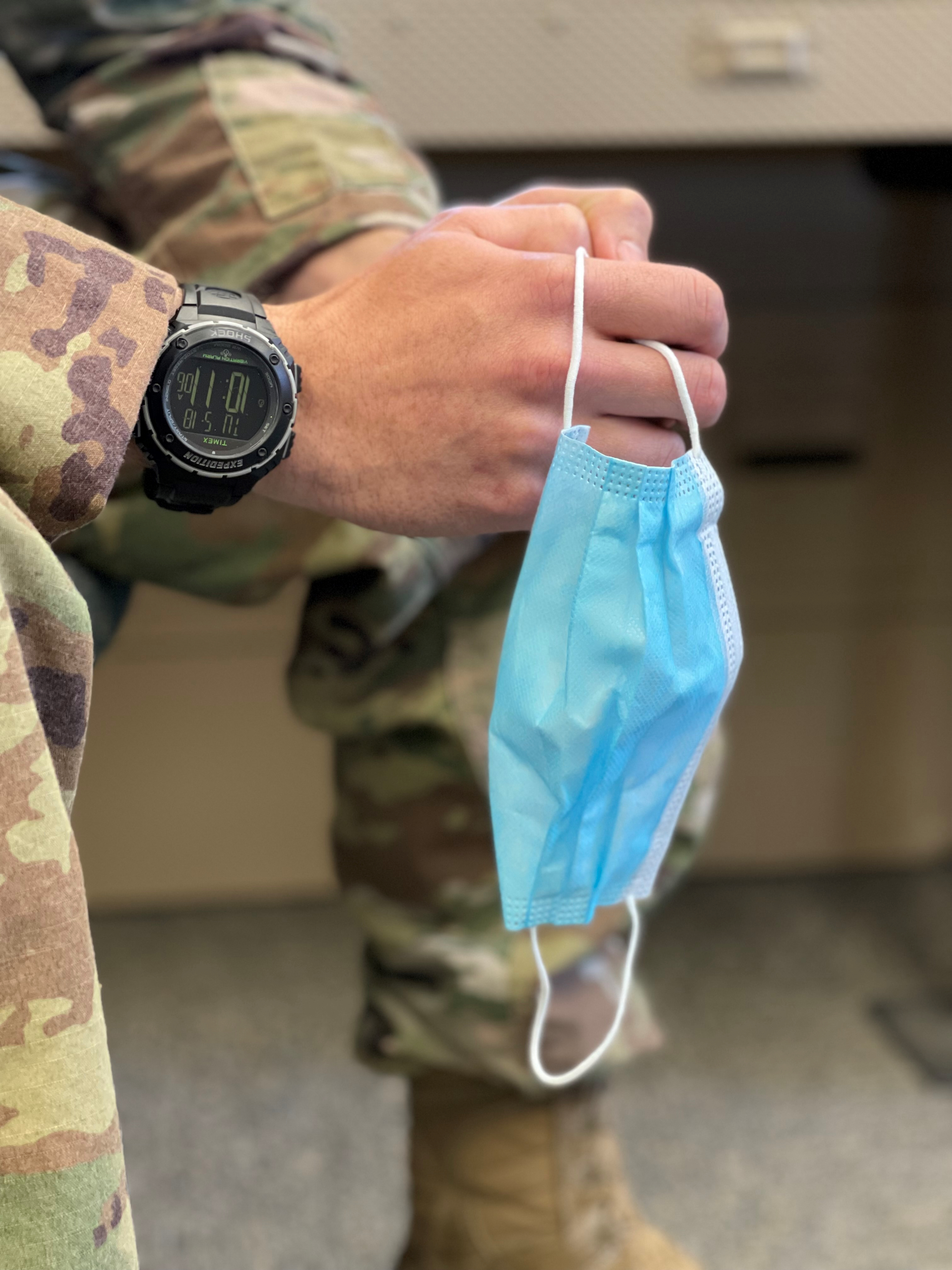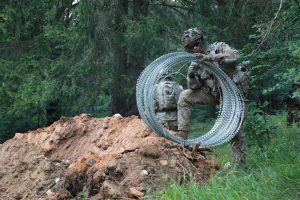Thoughts from a COVID Commander

Within a few weeks in the early Spring of 2020, COVID 19 caused an unprecedented level of confusion surrounding many aspects of military life, including force protection, workplace structure, and unit accountability. As states issued stay-at-home orders, military posts moved to mission-essential activities only, sending home the majority of Soldiers and Department of the Army civilians. It was an unprecedented situation, in which not only did Army units have to determine how to maintain operations from disparate, unclassified locations, but also how to do so while its Soldiers juggled work with child care, as school and daycares simultaneously shut their doors. Individual Army installations issued specific regulations and restrictions on travel, dining, and social activities that further stressed the Army population and its ability to complete the mission.
The most immediate impact to the force was that there was an urgent need for telework capabilities. The extent to which a unit can telework depends on its mission and normal battle rhythm. My company was lucky in that much of its work could be discussed over an unclassified medium and completed through emails, phone calls, and electronic portals. The line companies in my unit could not operate virtually to the same extent, and our sister units who primarily work in classified environments were even further hamstrung.
From a Company Commander standpoint, the biggest change was that over 50% of my daily energy was now being put toward trace operations for COVID-positive individuals, determining and overseeing Restriction of Movement (ROM) requirements for individuals who traveled, received visitors, or came in contact with a COVID positive individual, and constantly monitoring and communicating new guidance and regulations in regards to the pandemic. Essentially, in addition to all of the previous tasks and responsibilities as a headquarters company commander, I now had a large list of additional responsibilities as a company commander during a global pandemic.
Adapt and Overcome
As a computer geek, I never thought I would thank Microsoft for something, but the truth is that our unit would have been at a complete loss without Microsoft Teams. Within the first month of the pandemic, all of the Soldiers in my company had a Teams account and the application downloaded on their phones and/or computers. This
enabled us to conduct all our essential meetings virtually and communicate collaboratively in different chats. Over the next year, Teams became the platform for nearly all battle rhythm events, official communications, mandatory training, and information dissemination.
Something that cannot be conducted virtually is physical training (PT). Before the pandemic, my Company conducted daily physical training, with each morning beginning with a 0630 accountability formation. Such large formations were out of the question in the pandemic environment, so we moved to small group training, in which sections of the Company divided their Soldiers into groups of no more than six to conduct PT. This meant we now had Soldiers meeting all over the installation to work out and spread out, which would have been an accountability nightmare if it had not been for Teams.
While virtualization was a viable solution for planning and coordinating operations and training, it was not a solution for completing the missions to which we were assigned. The Army is a mobile, deployable fighting force, and that did not change just because a new illness was rearing its ugly head(s). During the pandemic, my Company sent Soldiers to other installations, the National Training Center, Muscatatuck Urban Training Center, and overseas deployments. Every time our Soldiers departed the local area- defined as 250 miles- they had to ROM for two weeks before returning to work. Often, the installation they were visiting had a similar requirement. This meant we had almost a month to account for on either end. A way we filled this time productively was with certification training. Our Resource Management section was able to reallocate resources that had been earmarked for now-canceled travel/training towards individual certification programs that Soldiers could complete virtually while on ROM or telework.
Reconstructing the Team
As gyms on the installation closed, and off-post gyms remained off-limits, sections had to do their best to utilize the equipment and space we owned as a unit for their workouts. As the COVID-19 rates went down and we began to re-implement Army practices, such as weighing Soldiers for compliance with the Army height/weight and body fat standards, it became apparent that sections were not using that equipment to the best of their ability, and many Soldiers were not conducting PT at all. Our first 100% weigh-in resulted in multiple additions to the Army Body Composition Program, and subsequent weigh-ins the next few months continued to produce similar results. The unfortunate reality is that not all individuals are internally motivated to exercise, eat right, and stay in fighting shape, which is one of the reasons unit PT has always been a cornerstone of a Soldier’s daily schedule. As the Soldiers started to receive vaccinations and the installation began to roll back restrictions on formation size, we reinstituted formal unit PT and tougher remedial PT for those on ABCP. These formations will not only help Soldiers get back to physical fitness standards, but also solve a number of other issues.
The Army relies on the Chain-of-Command as a communication, training, and discipline structure. There must be constant communication up and down that chain for operations to run smoothly and to take care of Soldiers. During the pandemic, we saw a breakdown in that communication chain, because in a virtual environment it is much easier to just individually message one person, and communication stove-pipes appear. These stovepipes led to section leads or the Command Team being the last to know that a Soldier had an issue or a training event had been changed. These issues are more quickly and clearly resolved when Soldiers look their Chain-of-Command in the face every day, such as at unit PT. With the Army movement cycle and a lack of face-to-face interaction, our Soldiers were placed in the unprecedented situation of being unable to place names with faces for those with whom they worked.
This leads to my last major point about how the pandemic degraded the Army team; it brought out lazy leaders. When 90% of communications occur over digital media- teams, email, etc- leaders become lazy. They send a couple of phone messages and consider their work for the day complete. Trust and understanding cannot be forged via email leadership. At a minimum, leaders should have been voice calling or, preferably, video calling their Soldiers daily, and this was not happening. Engaged leaders and their presence at formations, meetings, training events, and operations are vital to building a cohesive, effective team, and this is something we, as an Army, need to work towards as soon as conditions permit.
Applying Lessons Learned
It would be easy to say that COVID-19 and the year 2020 were terrible for the Army and society as a whole, but it would be remiss of leaders to dismiss some vital lessons we learned throughout the pandemic. Frankly, my Company’s training schedule and training plans have never been tighter or as forward-thinking. The need to consider ROM requirements, travel restrictions, and manpower limitations forced us to truly adopt time-proven Army planning methods and the platforms it has produced to create a shared understanding of unit training and operational tempo. Just because we will regain flexibility as the pandemic recedes does not mean we should let up on such good planning.
Additionally, the Army accidentally rolled out Army Combat Fitness Test (ACFT) equipment sets at exactly the right time. Although gyms were often closed or restricted to specific populations over the last year, my unit’s sections were able to utilize these mobile gyms to train. Regardless of how Congress changes the Army’s current intended rollout of the ACFT as the fitness test of record, the Army should continue to roll out these sets. Soldiers often criticize unit PT as one-dimensional and lacking in strength training, because the PT sessions are limited to some bodyweight exercises and running. Now, units can conduct quality muscular fitness training anywhere they form up using these ACFT sets.
A unique aspect of the pandemic is that it directly impacted Soldier-parents who thought they had childcare figured out. Suddenly, as learn-from-home took hold and daycares shut their doors, these men and women had to determine how to be full-time parents and full-time Soldiers. The Army requires that single and dual-military parents complete Family Care Plans (FCP) in the event that Army requirements interfere with their parental obligations. When the pandemic hit, these Soldiers were not the ones who had issues with family care, because they’d already thought through the worst-case scenario. It was Soldiers married to working, non-military spouses that did not have a plan and ended up on the list of Soldiers who needed special consideration in being assigned tasks and duties. The pandemic revealed the need for ALL Soldiers with dependents to complete a, possibly abbreviated, FCP, because just because a Soldier has a non-military spouse does not mean he or she has a stay-at-home spouse, and the Army needs to adapt to this 2021 reality.
Final Two Cents
I visualize my command experiences in two distinct phases- pre-pandemic and during the pandemic. Commanding a company during the pandemic was an entirely different challenge, as I navigated conducting battle rhythm events virtually, enforced health regulations and guidance to slow the spread of COVID-19, and worked to ensure the mission was accomplished despite the pandemic challenges. As we approach the
light at the end of the tunnel, I entreat leaders to dive back into in-person, engaged leadership as soon as possible, identify and eliminate communication stovepipes that have developed, and enforce Army standards, all without forgetting a few key lessons that pandemic operations taught us. Plan early and in detail, and constantly seek new
ways to resource and enhance training. Most importantly, never forget that Soldier welfare is every leader’s number one priority, so be present and stay engaged, no matter what challenges 2021 brings.
CPT Allyson Hauptman graduated from West Point in 2014 and commissioned as an Air Defense Artillery officer. Immediately following graduation she traveled to Tallinn, Estonia on a Rotary Scholarship to obtain her Master’s in Cybersecurity. In 2015 she transitioned to the Cyber Corps and, following graduation, reported to Cyber BOLC at Fort Gordon, GA.
Her first assignments as a Cyber Officer were as a CND Manager for a service team and a Future Operations Officer in the Cyber Protection Brigade. She graduated from the Cyber Captain’s Career Course in 2019 and reported to the new 915th Cyber Warfare Battalion, where she stood up and assumed command of Headquarters & Headquarters Company. She will begin her Ph.D. in Human-Centered Computing in fall 2021 with a follow-on assignment at the Army Cyber Institute. She is married to a fellow cyber officer with whom she has a son and daughter.



